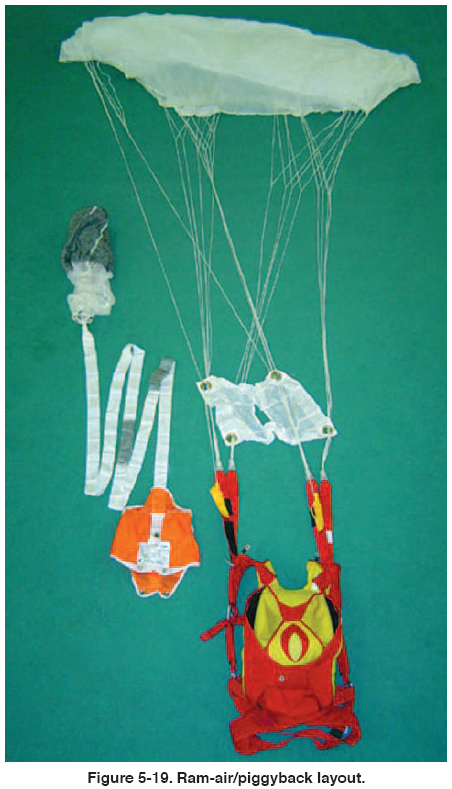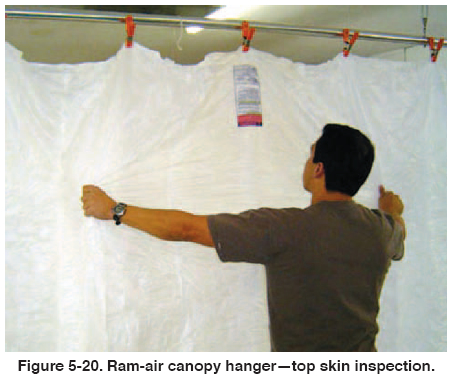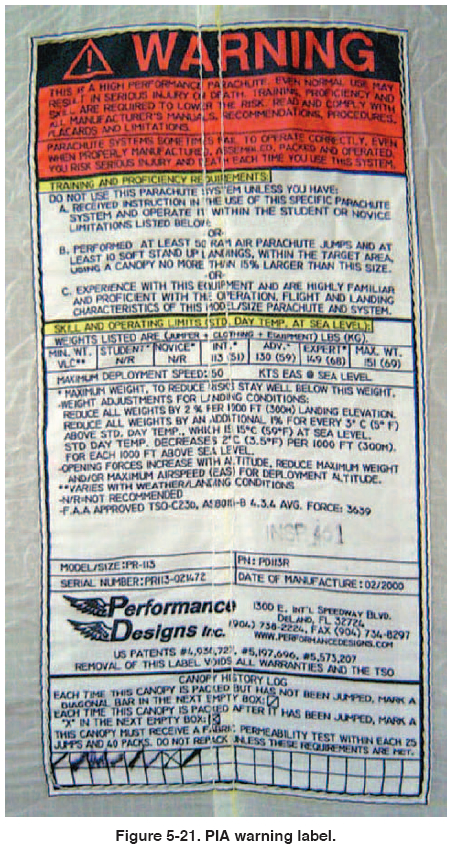Chapter 5
AIRING AND DRYING
During the inspection process, the rigger must determine
the condition of the canopy and system regarding dryness
and moisture. In the “old days” it was necessary for the
parachute to be aired and dried for 24 hours prior to packing
it. According to 14 CFR, subsection 65.129(c), “No
certificated parachute rigger may pack a parachute that
has not been thoroughly dried and aired.” This determination
is at the discretion of the rigger.
RAM-AIR RESERVES AND SPORT PIGGYBACK SYSTEMS
The following inspection procedures share much with the
previous section on round canopies. The differences
between ram-air reserves and sport piggyback systems
are identified in the following section. Inspect as follows:
PILOT CHUTE AND FREE BAG/BRIDLE
1. The rigger should inspect the pilot chute in the same
manner as in the section on round canopies.
2. The free bag should be checked to include all grommets,
especially those bags that have a through loop
configuration. Any sharpness in this area can result in a
damaged closing loop. For those free bags that utilize a
Safety-Stow ® locking system, make sure the elastic loop
is of the correct size, the elastic is in good shape, and the
zigzag stitching is secure. Many riggers fabricate these
loops in the field, which, in most cases, is an unauthorized
procedure. The Safety-Stow® loop is an integral part
of the approved reserve deployment system and is manufactured
under an approved quality control system from
approved materials. The rigger should use only OEM
approved parts for this.
3. Check the bridle for any damage or wear. For those bridles
that have assistor pockets, make sure the stitching is
secure and the pockets are not damaged. Check the
Velcro® on the line stow pocket for wear and security. If
the Velcro® does not hold securely, the parachute can
experience “line dump” during deployment, possibly
causing a malfunction or out of sequence deployment.
Some deployment bags use rubber bands to stow the lines.
If this is the case, check their condition and replace them
if necessary.
4. There are still older ram-air canopies in the field that
did not use a free bag but a diaper deployment system. If
this is the case, the diaper should be inspected the same as
that on a round canopy. Be sure to use the correct type
and length of bridle, since it is generally not the same as a
round bridle.
RAM-AIR RESERVE CANOPY
Figure 5-19 shows a typical ram-air reserve and harness
and container system layout. The terminology used in
describing the parts of the ram-air canopy is called out in
PIA Technical Standard TS-100, Standardized
Nomenclature for Ram-air Inflated Gliding Parachutes,
which can be found in the Appendix I of this handbook.

1. When inspecting and assembling ram-air canopies, begin
with the upper surface of the canopy. [Figure 5-20 on page
5-12] Work your way up and down the top panel of the cells
looking for any damage or contamination. Check the seams
for loose stitching and packing tabs if used, for security.

2. Check the trailing edge seam for secure stitching, paying
particular attention to the line attachment tapes and
their associated bar tacks. Next, look at the interior of the
cells, carefully checking the crossports for damage or
fraying of the edges of the fabric.
3. Now proceed to the lower surface of the canopy.
Carefully check all the seams and the line attachment
tapes and bar tacks.
4. Some manufacturers require the use of PIA Technical
Standard TS-108, Canopy Fabric Pull Test at certain
intervals. In addition, the manufacturer’s warning/TSO
label may require that the rigger mark the label to signify
each time it is repacked and after each use. [Figure 5-21]
This label will be found on the upper surface, trailing
edge of the canopy. It is important to comply with this
requirement, not only because the manufacturer requires
it, but also it establishes the trail of use for the canopy,
which allows future riggers (and the manufacturer) to
track its use and condition over time. Some riggers feel
that they are doing their customers a favor by not marking
the boxes in order to show it has little use when it
comes to selling it. Since most individuals have a specific
rigger pack their parachute on a regular basis, it
does not take a lot of detective work to inspect the rigger’s
logbook to see how many times they have packed
any particular parachute.

| 
